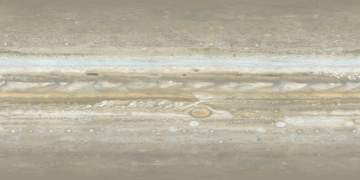
A Voyager 2 map of Jupiter
This map of Jupiter was made back in 2002. It is one of two Voyager 2 maps of Jupiter available at this website. This old map is less accurate than the other Voyager 2 map which is far newer (it was finished in 2025). In particular, it is positionally less accurate and the color is less accurate because this map is made from orange and violet filtered images only whereas for the newer map, green filtered images were also available. The resolution of this map is about 15% better though since the images used to create this map were obtained closer to Jupiter.
The map is in simple cylindrical projection with latitudes running with a uniform interval from -90 (bottom) to 90 (top). Latitudes are planetographic. Longitudes are in System III with longitude 0 at the left/right edges of the map and longitude 180 at the center. The map was originally in an arbitrary longitude system but this was corrected in August 2025. Prior to August 2025, System III longitude 0 was at x=4314 in the map but it is now at the left/right edges of the map as previously noted. At the same time the color was adjusted slightly. No other changes were made. The map should be rendered by projecting it onto an ellipsoid with an equatorial radius of 71516 km and a polar radius of 66871 km or some equivalent units
This map of Jupiter was created from roughly 90 images taken by the Voyager 2 spacecraft at the end of June 1979 from a distance of a little under 9 million km. These images have a resolution of roughly 90 km/pixel so to match this the map has a size of 5040x2520 pixels (14 pixels per degree).
At the end of June 1979 Voyager 2 was observing Jupiter every 1½ to 2 hours, typically obtaining a global 3x3 image mosaic through two color filters, orange and violet. For creating the map I used images covering an entire Jovian rotation (about 10 hours) plus some extra images for suitable overlap. There were no gaps in this coverage except for a very small region in the northern hemisphere and the southernmost regions due to the spacecraft's location north (about 6°) of Jupiter's equator.
For creating the map I used orange as red and violet as blue. I then determined which combination of the orange and violet images gave the best synthetic green images in a least squares sense by comparing orange, green and violet images taken from a larger distance when the spacecraft was observing Jupiter through a greater number of filters.
I then created the map by creating several sets of maps for each of the image sets that were obtained every 1½ to 2 hours. To create these maps I first had to process the raw spacecraft images by radiometrically correcting them, removing the effects of differing camera sensitivity across the field of view etc. (the image corners were noticeable brighter than areas near the center in the raw images). I then processed the resulting images in Photoshop to remove noise, using both built-in filters and manual 'painting'. The next step was to reproject the images to simple cylindrical projection, correcting for the different illumination and atmospheric scattering across the field of view on the fly. For this I needed to partially reverse engineer the spacecraft's viewing geometry, I had information on the spacecraft's location relative to Jupiter but the camera angle information (i.e. in which direction the camera was looking) was very inaccurate, typically off by 0.1 to 0.5° which is huge considering the fact that the camera's field of view is less than 0.5°.
Following this I had several orange and violet maps which I then aligned to each other before using them to create a synthetic green map. I then composited these into full color maps which I then mosaicked together into a global full color map, using Photoshop to remove seams and the effects of different illumination that weren't fully corrected for during the previous processing steps. I finally fixed the poles by reprojecting the polar regions to polar projection, making some minor adjustments to the north polar region and adding some cloned data to the south polar areas (as indicated above, the south pole wasn't visible in the images) and then reprojecting the fixed poles back to cylindrical projection.
The final step was to adjust the color balance. Since the map was in orange-green-violet (OGV) color instead of red-green-blue (RGB) I attempted to correct for this by mixing together different color channels to change the map's R and B color channels (which were really O and V). This resulted in somewhat more realistic color but I'm still not entirely satisfied with it, it doesn't quite look like what I see when looking at Jupiter through a telescope. There is more on this topic on the experimental renderings page.
Click the map below to download the full size map (4.5 MB 5040x2520 pixel JPG).